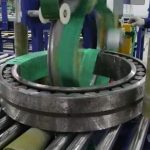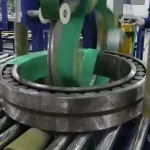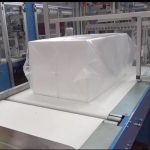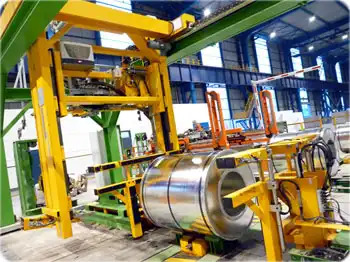coil wrapping machine for bearing
Custom Features vs. Standard Models: How to Choose a Bearing Wrapping Machine
In the realm of manufacturing and logistics, ensuring the integrity of products during transit is paramount. For industries dealing with bearings, the choice of a wrapping machine can significantly impact efficiency and cost-effectiveness. When it comes to selecting a bearing wrapping machine, businesses often face the dilemma of choosing between custom features and standard models. This article will explore the differences, advantages, and disadvantages of both options, helping you make a well-informed decision tailored to your operational needs.
Understanding Bearing Wrapping Machines
What is a Bearing Wrapping Machine?
A bearing wrapping machine is designed to securely wrap bearings in protective materials, such as plastic film or paper, before they are shipped or stored. This process helps prevent damage, contamination, and rust during transportation and storage, ensuring that the products arrive at their destination in optimal condition.
Importance of Wrapping in Bearing Logistics
In the bearing industry, the integrity of products is crucial. Bearings are often used in critical applications, such as automotive and machinery components, where quality cannot be compromised. Proper wrapping not only protects bearings from physical damage but also shields them from environmental factors like moisture, dust, and other contaminants.
Standard Models: An Overview
What Are Standard Models?
Standard models of bearing wrapping machines are typically mass-produced and designed to meet general wrapping needs. These machines come equipped with basic features that allow for efficient wrapping of various bearing sizes and types.
Advantages of Standard Models
- Cost-Effective: Standard models usually have a lower purchase price compared to custom machines, making them suitable for businesses with budget constraints.
- Ease of Use: These machines often feature straightforward controls, allowing for quick training and minimal downtime when onboarding new staff.
- Availability: Standard models are readily available from multiple suppliers, enabling quicker implementation compared to custom solutions.
- Reliability: Being mass-produced, standard models have been tested across various conditions, providing a level of reliability that businesses can count on.
Disadvantages of Standard Models
- Limited Customization: Standard models may not cater to specific operational requirements, potentially resulting in inefficiencies.
- Inflexibility: As business needs evolve, standard machines may require replacement rather than modification, leading to additional costs.
- Potential for Overhead: If the machine’s capabilities exceed your actual needs, you may end up paying for features that are unnecessary for your operations.
Custom Features: A Deeper Dive
What Are Custom Features?
Custom features refer to modifications made to a standard bearing wrapping machine to better suit specific operational needs. These features can include adjustable wrapping speeds, specialized wrapping materials, or integration with existing production lines.
Advantages of Custom Features
- Tailored Solutions: Custom machines can be designed to meet the unique requirements of your operation, enhancing efficiency and productivity.
- Improved Workflow: A machine designed with your specific processes in mind can streamline operations, reducing bottlenecks and increasing throughput.
- Scalability: Custom solutions can be built with future growth in mind, allowing for adjustments as your production needs evolve.
- Enhanced Safety: Custom machines can incorporate specific safety features relevant to your operations, minimizing the risk of accidents.
Disadvantages of Custom Features
- Higher Initial Costs: Custom machines typically come with a higher price tag due to the specialized engineering and design involved.
- Longer Lead Times: The development and manufacturing process for custom machines can take significantly longer than for standard models, potentially delaying implementation.
- Complexity in Operation: Custom machines may require more extensive training for staff, which can lead to initial operational challenges.
Key Factors to Consider When Choosing a Machine
1. Production Volume
Understanding your production volume is essential when selecting a wrapping machine. High-volume operations may benefit from custom features that enhance speed and efficiency, while lower-volume operations might find standard models sufficient.
2. Type of Bearings
Consider the types of bearings you will be wrapping. Different bearing sizes and materials may require machines with specific capabilities that standard models do not offer. Custom features can provide the necessary adjustments for various bearing types.
3. Available Space
Evaluate the space available for the wrapping machine in your facility. Custom models can be designed to fit specific spatial requirements, while standard models may not always fit your layout.
4. Budget Constraints
Your budget will significantly influence your choice between standard and custom machines. While custom features can offer tailored solutions, they come at a higher cost. Assess your budget to determine the best option.
5. Future Growth Potential
Consider your company’s growth trajectory. If you anticipate expanding your operations, investing in a custom machine that can adapt to future needs may be more beneficial than a standard model.
6. Maintenance and Support
Evaluate the maintenance requirements and support options for both standard and custom machines. Custom machines might require specialized knowledge for maintenance, while standard models may have more readily available support.
7. Integration with Existing Systems
Determine how the wrapping machine will integrate with your current production line. Custom features can facilitate better integration, while standard models may require additional adjustments.
8. Safety Features
Safety should always be a priority in any operational setting. Assess the safety features available in both standard and custom machines, ensuring that they meet your specific safety requirements.
Comparing Costs: Short-Term vs. Long-Term
Short-Term Costs
In the short term, standard models generally incur lower initial costs. This can be appealing for businesses with limited budgets or those looking to implement a solution quickly.
Long-Term Costs
However, custom machines, while initially more expensive, can lead to significant savings over time. Improved efficiency, reduced damage rates, and lower maintenance costs can offset the initial investment.
Total Cost of Ownership (TCO)
When evaluating costs, consider the Total Cost of Ownership (TCO). This includes not just the purchase price but also maintenance, operational efficiency, and potential downtime. Custom machines may offer a lower TCO in the long run.
Making the Decision: Questions to Ask
1. What are my specific operational needs?
Understanding your unique requirements is crucial in determining whether a standard model or custom features are necessary.
2. How much am I willing to invest?
Set a budget and consider both initial and long-term costs when making your decision.
3. What level of support will I need?
Evaluate the support options available for both types of machines and choose one that aligns with your operational capabilities.
4. How will this impact my workflow?
Consider how the choice of machine will affect your overall workflow and productivity.
Real-World Applications
Case Study: Standard Model Success
A small manufacturing plant opted for a standard bearing wrapping machine to meet its production needs. With a moderate output and straightforward workflow, the plant benefited from the cost-effectiveness and ease of use of the standard model, leading to improved efficiency without significant upfront investment.
Case Study: Custom Feature Implementation
Conversely, a large bearing manufacturer required a custom wrapping solution to accommodate its high volume and diverse product range. By investing in a custom machine with adjustable features, the facility significantly enhanced its operational efficiency, reduced labor costs, and improved product integrity during shipment.
Conclusion
Selecting the right bearing wrapping machine is a critical decision that can greatly impact your operational efficiency and cost-effectiveness. By thoroughly evaluating your production needs, budget constraints, and long-term goals, you can make an informed choice between standard models and custom features. Whether you opt for a reliable standard machine or invest in a tailored solution, the right wrapping machine will ultimately enhance your operations and contribute to your company’s success. Take the time to analyze each option carefully, and you’ll find the perfect fit for your bearing wrapping needs.







